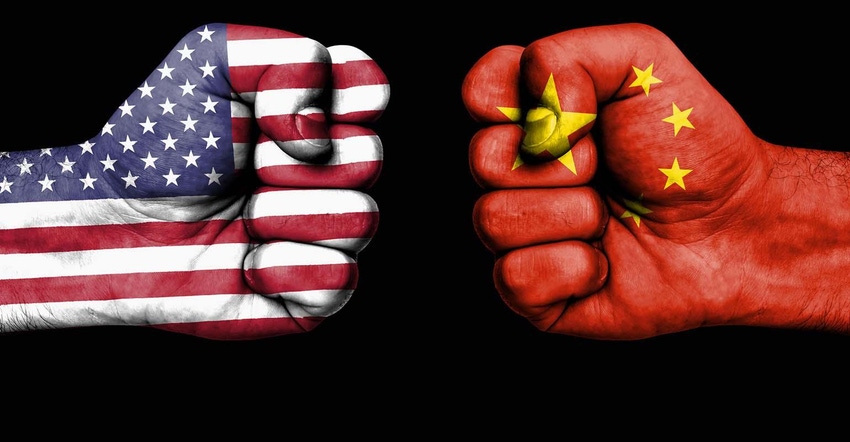August 29, 2018

It probably seemed like a simple idea: Impose 25 percent tariffs on $34 billion of Chinese products to get China to stop stealing American intellectual property and technology, and they’ll cave in.
But things are rarely as simple as they seem in international trade, and the backlash to the tariffs on Chinese exports is now inflicting the most pain on a group who voted almost exclusively for President Trump – U.S. farmers.
“I had to update my slides this morning because there are new tariffs the U.S. has put in place on Chinese products,” said Dr. Luis Ribera, professor and Extension economist in the Department of Agricultural Economics at Texas A&M University. “And China retaliated with about $16 billion worth on top of what they had tariffs on.”
See also:
Part 1: Trade wars hurt producers, consumers
Part 2: NAFTA has been successful; agreement expected soon
Ribera, who also serves as program director for international projects at Texas A&M’s Agricultural and Food Policy Center, was speaking on “Agricultural Trade: China, NAFTA and Brazilian Agriculture in Focus,” a webinar presented by the University of Arkansas System Division of Agriculture. Click on https://bit.ly/2MWvZS7.
U.S. and Chinese trade representatives have been negotiating, but the latest reports about their progress have not been good. USDA also announced Monday (Aug. 27) farmers will receive $4.7 billion in payments to offset losses from the tariffs. Industry groups say the checks will be insufficient.
Ironically, the U.S. has enjoyed an agricultural trade surplus with China with U.S. farmers shipping almost twice as much in agricultural commodities there as Chinese growers do to the U.S.
Ag Trade Surplus with China
“We have a deficit in overall products,” said Ribera, “but we have a big trade surplus in agriculture with 2017 U.S. ag exports to China totaling $19.1 billion and Chinese exports to the U.S. $9 billion.
“You can see that over the years, we have grown quite a bit,” he said, referring to a table depicting the U.S.-China Agricultural Trade Balance. “From 2005 to 2017 we went from $5.1 billion to almost $20 billion.”
Of the $19 billion in U.S. agricultural exports to China in 2017, $12 billion to $14 billion were oilseeds and soybeans. Grains and feeds were next at $2.1 billion; livestock and meats, third at $1.78 billion; and cotton, fourth at $1.18 billion.
American Soybean Association leaders have been vocal in their criticism. ASA was one of the first commodity organizations to open an office in China in the 1990s, and farmers have spent 30 years building the market to current levels.
“It is imperative that we maintain the robust market we have worked so hard for decades to establish with China,” said ASA President John Heisdorffer of Keota, Iowa. “China is our top market, importing 31 percent of our crop last year. We need to continue to do business with them without the sting of these tariffs.”
Since the talk of tariffs began, soybean prices have dropped more than $2 a bushel. The price of cotton has gone from above 90 cents for the first time in years to around 80 cents per pound in recent weeks.
The Trump administration has applied tariffs on Chinese steel and aluminum, claiming China has been appropriating U.S. intellectual property through “forced technology transfer and outright theft.”
“This has been known for a long, long time,” said Ribera. “The European Union has also complained about it. Companies have also known about it, and they’ve complained. But they were still making profits.
Nobody Wins
“What this administration has done is they’ve said, ‘Okay, put China on the stand and try to correct it,’” said Ribera “I think it’s understandable how you can have differences of opinion. This administration has tried to have negotiations while at the same time swapping tariffs, but, as I’ve mentioned before, in a tariff war nobody wins.”
The way to resolve trade issues, he said, is to “sit down and try to figure things out.”
The U.S. has imposed 25 percent tariffs on $60 billion of Chinese products, including industrial machinery, medical devices, auto parts and other steel and aluminum items. In their initial response, the Chinese levied tariffs on mainly agricultural products from the U.S. After the new U.S. tariffs on motorcycles, speedometers and antennas went in place, China hit back with tariffs on U.S. chemical products and diesel fuel.
When you look at how much of their income they spend on food – 25 percent, compared to 6.3 percent for U.S. consumers, the potential for higher food prices resulting from the tariffs on food products could hit the Chinese people hard.
“Hopefully, it's going to get resolved pretty quickly, and we can have an agreement soon,” said Ribera. “China is a big market for our agricultural products. The Chinese people, on the other hand, don't want this to happen because they are going to be affected directly on their food expenses.”
About the Author(s)
You May Also Like






